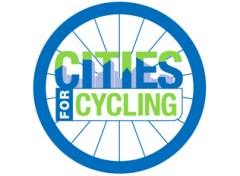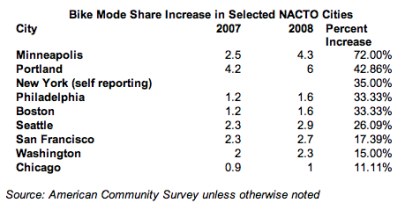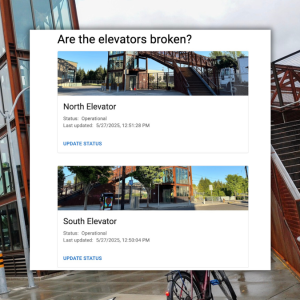
Cities for Cycling, a new initiative to push bike planning innovation in America with roots in Portland, was officially launched at an event in Washington D.C. last night.
Streetsblog was at the event and reported this from New York City DOT Commissioner Janette Sadik-Khan:
“Some of the most celebrated and popular [bike] improvements are not even in the national guidelines,” Sadik-Khan explained, adding that C4C ultimately aims to help develop “a new MUTCD, designed for cities, not highways.”
Also at the event, held near Capitol Hill, were Portland Congressman Earl Blumenauer and Obama’s Federal Transit Administration head Peter Rogoff. According to Streetsblog, Blumenauer and Sadik-Khan “emphasized” that big jumps in bike spending “would require hard work and political organizing on the part of bike advocates.” This is political-speak for the importance of activism to create the political cover for pro-bike legislators like Blumenauer to take more bold steps.
Speaking of politics, Streetsblog also reported that Blumenauer mentioned that “in fairness” he feels that it would be a smart move if there was some sort of “tiny fee” that came from “the bicycling community” to help pay for better roads and infrastructure.
We’ve been down this road before. Last year, the BTA said they would support the “concept” of a bicycle excise tax. Let’s hope Blumenauer steps very carefully around this issue.
Cities for Cycling, which is a project of the National Association of City Transportation Officials (NACTO), has also unveiled their new website. The site includes a set of Emerging Best Practices Sheets — which are essentially white papers on some of the innovative bikeway treatments that aren’t found in the widely used federal guidelines. Among those treatments are “Bicycle Preferred Streets“, (a.k.a. bicycle boulevards).
In a press release from NACTO about this new initiative, they included a chart illustrating the rise in bike commuting of participating cities:

Check out CitiesForCycling.org to learn more.







Thanks for reading.
BikePortland has served this community with independent community journalism since 2005. We rely on subscriptions from readers like you to survive. Your financial support is vital in keeping this valuable resource alive and well.
Please subscribe today to strengthen and expand our work.
if I am going to be asked to pay for infrastructure I do not want, I will want a seat at the table.
this particular effort is funded by two industry groups, Bikes Belong and SRAM Cycling Fund, both of which are focused on recreational cycling. all I want are some sharrows, some lower speed limits, some signalized crossings of arterials, and some education and enforcement. how much would that cost, really? and even if we do build a bunch of sidepaths, why should it not be the responsibility of motorists to pay for these, which primarily serve their convenience by pushing cyclists to the side?
> Blumenauer mentioned that “in fairness” he feels that it would be a smart move if there was some sort of “tiny fee” that came from “the bicycling community” to help pay for better roads and infrastructure.
Didn’t I just see a report that a huge and growing chunk of highway spending isn’t coming from highway sources? (Or roadway spending from non-car sources?)
But here’s my suggestion – find some material used by both cars and bikes (say, rubber), put a tax on that, and then split the revenue based on the mode split you’d like to see (say, 75% going to bike infrastructure and %15 to transit, and %10 to road funding). Seems fair to me. 😉
“all I want are some sharrows, some lower speed limits, some signalized crossings of arterials, and some education and enforcement. how much would that cost, really?”
i am perfectly happy with things the way they are now but i want much, much more.
“this particular effort is funded by two industry groups”
the organization is supported “in part” by these groups. although i personally believe that capitalist running dogs should be sent to obedience school, a bit of pragmatism is required.
plus how the frak could you not be pleased by an organization that has this on their front page:
Emerging Best Practices Sheets
* Bike Boxes
* Bicycle Preferred Streets
* Bike Signals
* Buffered Bike Lanes
* Colorized Pavement
* Contra-flow Bike Lanes
* Cycle Tracks
* Shared Roadway Markings
i think a bike excise tax is a terrific way to raise a bit of money for bike infrastructure. i think it should be progressive tax (e.g. a $100 bike should be taxed far less than a $2K CF bike).
Have we not figured out that taxing bikes is incredibly counter productive?
It would cost money to hire people and create the infrastructure to license/tax people who ride bikes. Likely more than the gains would be in return.
What do we do about kids that ride bikes to school? Or, if someone is a very occasional bike rider that might not go out of their way to pay a fee to ride a carbon neutral people powered machine?
Do we start taxing people who use sidewalks and cross streets?
Award people for not polluting.
Having one form of autonomous transport seems hardly out of hand. Especially when the costs to create decent infrastructure for cycling are not even a penny on the dollar.
One we get to nickels on the dollar, let’s re-open this can. Maybe…
Why maybe? Simply because as a motorist “I” should be paying fees to help “protect” the vulnerable road users: i.e. Pedestrians and Cyclists.
I pay the same fee all the other people who do, but because cycling is free, healthy, and aides in lessening pollution over my car…I choose my bike over my car 90% of the time.
Why complicate things?
Out of curiosity, is licensing fees a part of the Dutch system?
…actually let’s open the tax-can or worms when WE have infrastructure as well developed as Copenhagen and Amsterdam.
Until then….
It may be worth mentioning for non-wonk readers that MUTCD stands for Manual on Uniform Traffic Control Devices. It’s a federal document that recommends how transportation infrastructure should be designed. The recommendations aren’t mandatory or enforced, but the accepted standards have the effect of protecting cities and states from liability in the case that someone gets in a crash and sues, accusing that the traffic control design was defective. Because they’re afraid of getting sued, most governments won’t stray from the MUTCD, which means the development of new types of facilities is restricted to the slow speed at which the MUTCD reviews new designs, or how risk-averse your city happens to be.
Its kinda funny to expect cyclists to pay share of road costs, to be licensed, etc… No one expects anything from pedestrians that use public sidewalks. No one tries to license and tax pedestrians. After all, most cyclists do own cars. So are pedestrians.
sparewheel 3, it is not so much that i am opposed to some of these things, though the bike box is an inappropriate solution to the problem of striping bike lanes into the right hook and cycletracks create needless conflict points at intersections, etc. in other words, i myself will not use these facilities, but i do understand how they are useful in attracting the less “intrepid.” my problem is that these facilities are being implemented in an environment where we have far to the right and mandatory sidepath laws, so that (for example) when i take the travel lane at an intersection in order to avoid the right hook, rather than use the bike box, i am technically violating the traffic code. any agenda that pushes facilities for the benefit of people who refuse to learn how to ride in traffic must also include getting rid of the far to the right and mandatory sidepath laws, or i have to oppose it.
“No one expects anything from pedestrians that use public sidewalks.”
Public sidewalks are used by virtually everyone and should be funded out of general tax funds. Even so its ironic that many (if not most) sidewalks in portland are funded and maintained by adjacent property owners. I see no reason that improved biking infrastructure cannot be partly funded by modest taxes on wealthier bike purchasers.
(If only highway infrastructure was payed for solely by gas and vehicle excise taxes.)
While I understand that people understandbly get fired up about cyclings being assessed, I would note that the larger story here is that local governments are organizing to create a separate institution as a counter-weight to AASHTO.
ASSHTO is highway-driven and is making it very hard for cities – especially those not willing to stick their neck out – to implement bicycle treatments that are commonplace in Europe.
“are”(#1) – While funding for some research is coming from bike industry groups, this process is being driven by progressive local governments.
I meant “cyclists” being assessed. Sorry for the typo.
“Speaking of politics, Streetsblog also reported that Blumenauer mentioned that “in fairness” he feels that it would be a smart move if there was some sort of “tiny fee” that came from “the bicycling community” to help pay for better roads and infrastructure.” bikeportland/maus
I think Blumenauer is doing basically good work, but his mention of a fee out of fairness seems to be a bit of wishful, misplaced thinking. It sounds as though what he could really benefit from in his work to promote greater use of the bike for transportation, is a simpler and more effective way of impressing upon the public that the percentage of the public comprising “the bicycling community”…already does make a substantial contribution to help pay for better roads and infrastructure.
Regarding the MUTCD/ Manual on Uniform Traffic Control Devices: Is it this document that’s being used by transportation departments of cities counties and the state to build bike lanes that, with some exceptions, riders of bikes are legally required by state law to ride in?
If so, does it contain specific references to safe, reasonable speed limits for bike lane designs it recommends being built that are compatible with the content of ORS 814.420?
‘From ORS 814.420:
(2) A person is not required to comply with this section unless the state or local authority with jurisdiction over the roadway finds, after public hearing, that the bicycle lane or bicycle path is suitable for safe bicycle use at reasonable rates of speed.’
Sorry if I seem to be dwelling on this issue, but I’m just curious how the present correlation between bike infrastructure and the law relating to them have come about.
Have any of you commenting on Blumenhauer stopped to think about the game of politics a little? I see it as this, Rep. Blumenhauer is trying to push an agenda with other Reps who may or may not see his agenda as valid, if he mentions the idea of a tax from cyclists he may then gain favor from other Reps who otherwise wouldn’t agree to his point. My guess is he’ll play the lets talk bike tax with them for a while, get some real work done and then when it comes time to get funding for the propositions he’ll look at a number of angles for needed funding and Oregonians will then vote on the propositions. And probably turn down a bike tax.
don’t know why Blumenauer should be talking about bike “fees” at all, as these would not be imposed federally
the MUTCD is a publication of the federal highway administration. it regulates signage and does not deal in policy questions, such as whether there should be far to right or mandatory sidepath laws
http://mutcd.fhwa.dot.gov/pdfs/2003r1r2/mutcd2003r1r2complet.pdf
NACTO’s total funding as of 2007 was only about 50k, and this seems to have come from NYU
http://tfcny.fdncenter.org/990_pdf_archive/201/201874085/201874085_200712_990.pdf
so whatever Bikes Belong and SRAM are giving seems likely to be the entire budget. are you (steve 10) saying they will not steer the agenda?
are,
in your first comment you write that Bikes Belong and SRAM are focused on “recreational cycling”. to my knowledge, that’s not exactly accurate. what makes you say that?
did you know that Bikes Belong is THE major supporter of the national Safe Routes to School effort? Not exactly what I’d call recreational cycling.
are…thanks. It appears that AASHTO (American Association of State Highway and Transportation Officials) may be the group whose bike lane design standards have been used by transportation departments in Oregonand elsewhere. An Arizona’s bike-pedestrian group has a nice little page that explains some of this:
Bicycle Facility Design Guidelines
No mention in that article, of whether AASHTO suggests a reasonable bicycle use speed for the bike lane designs it advises.
I noticed Steve Hoyt-McBeth #10 mentioned AASHTO.
in the bike master plan adopted some years ago, PBoT cited AASHTO and ODoT as sources for their facilities specs. generally they say a five foot bike lane next to an eleven foot travel lane, but they are willing to accept a four foot lane next to a ten foot travel lane for limited distances. or something like that.
http://www.portlandonline.com/shared/cfm/image.cfm?id=40414
pages 84 and following. it had not occurred to me (or probably to them) that “reasonable speed” needed to be specified. y’know, 18 or 20 mph or so.
jonathan,
let me first say that i think safe routes to schools is at least potentially a good program. how to normalize transportational cycling twenty years out is to indoctrinate kids today. no disagreement there. however.
the National Center for Safe Routes to School is a program of the Federal Highway Administration. so presumably this in itself is not the effort you are saying Bikes Belong is funding.
the Safe Routes to School National Partnership is a coalition of nonprofits, government agencies, etc. which is “hosted” by Bikes Belong. unclear how much money is involved, as the “partnership” does not file a separate Form 990. individual contributions are to be made to the Bikes Belong Foundation, which showed zero income on its Form 990EZ for 2006.
http://tfcny.fdncenter.org/990_pdf_archive/204/204306888/204306888_200612_990EZ.pdf
other funding sources for the “partnership” include Robert Wood Johnson, SRAM Cycling Fund, and Kaiser Permanente. apparently RWJ gave about 1.5 mil. this year, and SRAM gave a couple hundred thousand. again, unclear what Bikes Belong’s monetary contribution was.
the Bikes Belong Coalition is an organization of suppliers and retailers, makes grants primarily to offroad trail and other sidepath projects. they say so right in their grants brochure
http://www.bikesbelong.org/files/GrantsBrochure2009.pdf
their grant history for 2005 and 2006 is shown in the Form 990 returns filed for those years
http://tfcny.fdncenter.org/990_pdf_archive/391/391946697/391946697_200509_990O.pdf
http://tfcny.fdncenter.org/990_pdf_archive/391/391946697/391946697_200512_990O.pdf
http://tfcny.fdncenter.org/990_pdf_archive/391/391946697/391946697_200612_990O.pdf
no mention of safe routes. some of these grants are for “advocacy,” but this includes stuff like the Chicago Bike Fed’s sunday parkways. far and away the hugest amount, a couple hundred thousand, half of their total grant money, went to the League of American Bicyclists, which in recent years has turned its back on vehicular cyclists.
so, yeah, i will stand by the statement that Bikes Belong is focused on recreational cycling.
incidentally, jonathan, i have tried repeatedly to post a reply to your comment 17, but it does not appear. probably running over some character maximum. will try to edit it down.
I would think so…considering that the bike lane law, ORS 814.420 specifies that
bike lane use is not required unless the lanes have been approved for “…safe bicycle use at reasonable rates of speed.”.
It seems as though at the ‘public hearing(s)’ where bike lanes are approved, some idea of what represents a reasonable rate of speed for the bike lanes being approved would have had to have been specified, and entered into the minutes for those meetings. If this wasn’t done… .
or possibly there was a bunch of html in what i was trying to post, but my rant on bikes belong is now posted over here:
http://taking-the-lane.blogspot.com/2009/12/whose-agenda.html